Posts tagged "database":
CMU 15-445 notes: Hash Tables
This is a personal note for the CMU 15-445 L7 notes as well as some explanation from Claude.ai.
1. DBMS data structure application
- Internal meta-data: page tables, page directories.
- Tuple storage on disk.
- Table indices: easy to find specific tuples.
1.1. Design decisions
- Data layout for efficient access.
- Concurrent access to data structures.
2. Hash tables
- Implements an associative array that maps keys to values.
- On average \(O(1)\) operation complexity with the worst case \(O(n)\); \(O(n)\) storage complexity.
- Optimization for constant complexity is important in real world.
2.1. Where are hash tables used
- For tuple indexing. While tuples are stored on pages with NSM or DSM, during the query the DBMS needs to quickly locate the page that stores specific tuples. It can achieve this with separately-stored hash tables, where each key can be a hash of a tuple id, and the value points the location.
3. Hash function
- Maps a large key space into a smaller domain.
- Takes in any key as input, and returns a deterministic integer representation.
- Needs to consider the trade-off between fast execution and collision rate.
- Does not need to be cryptographically.
- The state-of-art (Fall 2023) hash function is XXHash3.
4. Hashing scheme
- Handles key collision after hashing.
- Needs to consider the trade-off between large table allocation (to avoid collision) and additional instruction execution when a collision occurs.
5. Static hashing scheme
- The hash table size is fixed; the DBMS has to rebuild a larger hash table (e.g., twice the size) from scratch when it runs out of space.
5.1. Linear probe hashing
- Insertion: when a collision occurs, linearly search the adjacent slots in a circular buffer until a open one is found.
- Lookup: search linearly from the first hashed slot until the desired entry or an empty slot is reached, or every slot has been iterated.
- Requires to store both key and value in the slot.
- Deletion: simply deleting the entry prevents future lookups as it becomes empty; two solutions:
- Replace the deleted entry with a dummy entry to tell future lookups to keep scanning.
- Shift the adjacent entries which were originally shifted, i.e., those who were originally hashed to the same key.
- Very expensive and rarely implemented in practice.
- The state-of-art linear probe hashing is Google
absl::flat_hash_map.
5.1.1. Non-unique keys
- The same key may be associated with multiple different values.
- Separate linked list: each value is a pointer to a linked list of all values, which may overflow to multiple pages.
- Redundant keys: store the same key multiple times with different values.
- A more common approach.
- Linear probing still works, if it is fine to get one value.
5.1.2. Optimization
- Specialized hash table based on key types and size; e.g., for long string keys, one can store the pointer or the hash of the long string in the hash table.
- Store metadata in a separate array, e.g., store empty slot in a bitmap to avoid looking up deleted keys.
- Version control of hash tables: invalidate entries by incrementing the version counter rather than explicitly marking the deletion.
5.2. Cuckoo hashing
- Maintains multiple hash tables with different hash functions to generate different hashes for the same key using different seeds.
- Insertion: check each table and choose one with a free slot; if none table has free slot, choose and evict an old entry and find it another table.
- If a rare cycle happens, rebuild all hash tables with new seeds or with larger tables.
- \(O(1)\) lookups and deletion (also needs to store keys), but insertion is more expensive.
- Practical implementation maps a key to different slots in a single hash table.
6. Dynamic hashing schemes
- Resize the hash table on demand without rebuilding the entire table.
6.1. Chained Hashing
- Maintains a linked list of buckets for each slot in the hash table; keys hashed to the same slot are inserted into the linked list.
- Lookup: hash to the key’s bucket and scan for it.
- Optimization: store bloom filter in the bucket pointer list to tell if a key exist in the linked list.
6.2. Extendible hashing
- Improve chained hashing to avoid letting chains grow forever.
- Allow multiple slot locations in the hash table to point to the same chain.
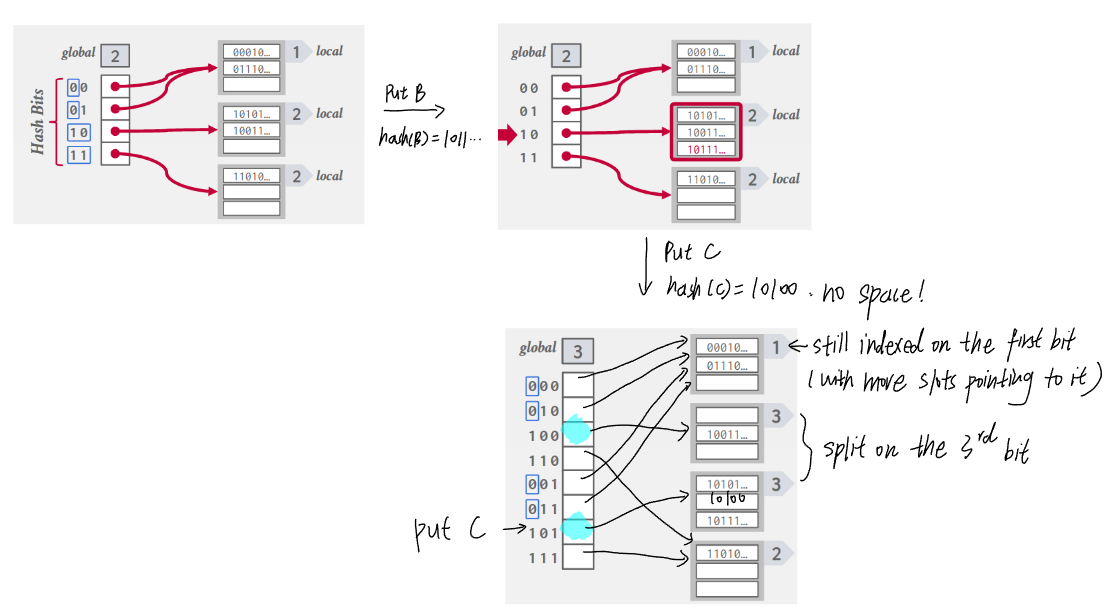
6.3. Linear hashing
- Maintains a split pointer to keep track of next bucket to split, even if the pointed bucket is not overflowed.
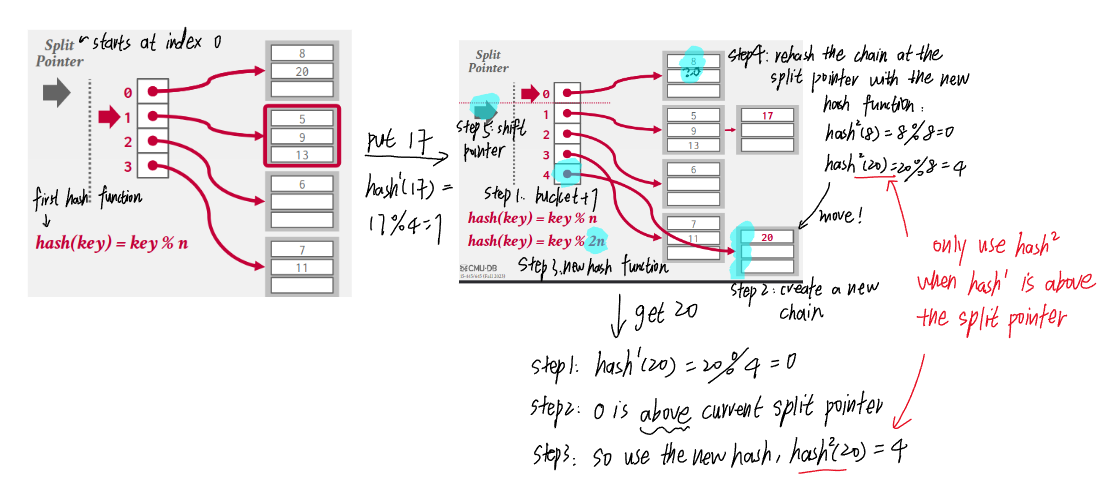
- There are always only 2 hash functions: \((key\ mod\ n)\) and \((key\ mod\ 2n)\) where \(n\) is the length of buckets when the split pointer is at the index 0 (i.e., the bucket length at any time is \(n + index(sp)\)).
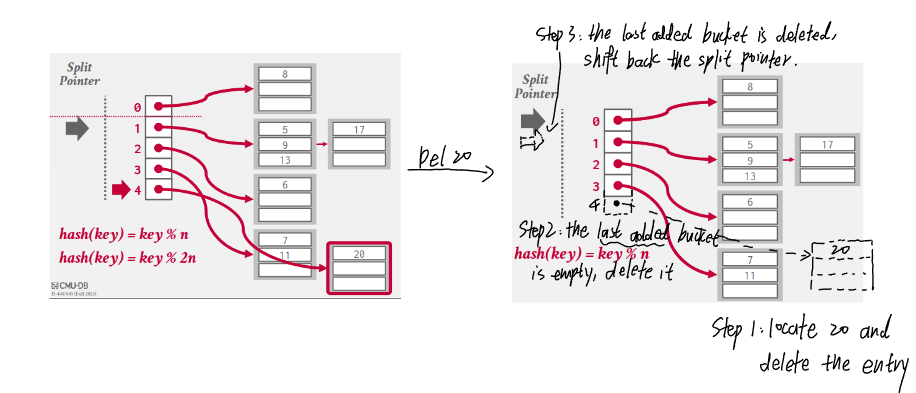
- Why does \(k\ mod\ 2n < n + sp\) hold?
- A key is only mod by \(2n\) if the result of \((k\ mod\ n)\) is above the split pointer, i.e., \(0 \leq k\ mod\ n < sp)\).
- Let \(r = k\ mod\ n\), then \(k = pn + r\) and \(0 \leq r < sp\).
- Let \(r' = k\ mod\ 2n\), then \(k = q(2n) + r'\).
- If \(p = 2m\), then we also have \(k = m(2n) + r = q(2n) + r'\), in this case \(0 \leq r = r' < sp\).
- If \(p = 2m + 1\), then we have \(k = m(2n) + r + n = q(2n) + r'\), in this case \(n \leq r' = n + r < n + sp\).
CMU 15-445 notes: Memory Management
This is a personal note for the CMU 15-445 L6 notes as well as some explanation from Claude.ai.
1. Goals
- Manage DBMS memory and move data between the memory and the disk, such that the execution engine does no worry about the data fetching.
- Spatial control: keep relevant pages physically together on disk.
- Temporal control: minimize the number of stalls to read data from the disk.
2. Locks & Latches
- Both used to protect internal elements.
2.1. Locks
- A high-level logical primitive to allow for transaction atomicity.
- Exposed to users when queries are run.
- Need to be able to rollback changes.
2.2. Latches
- A low-level protection primitive a DBMS uses in its internal data structures, e.g., hash tables.
- Only held when the operation is being made, like a mutex.
- Do not need to expose to users or used to rollback changes.
3. Buffer pool
- An in-memory cache of pages read from the disk.
- The buffer pool’s region of memory is organized as an array of fixed size pages; each array entry is called a frame.
- When the DBMS requests a page, the buffer pool first searches its cache, if not found, it copies he page from the disk into one of its frame.
- Dirty pages (i.e., modified pages) are buffered rather than writing back immediately.
3.1. Metadata
- Page table: An in-memory hash mapping page ids to frame locations in the buffer pool.
- Dirty flag: set by a thread whenever it modifies a page to indicate the pages must be written back to disk.
- Pin/Reference counter: tracks the number of threads that are currently accessing the page; the storage manager is not allowed to evict a page if its pin count is greater than 0.
3.2. Memory allocation policies
- The buffer pool decides when to allocate a frame for a page.
- Global policies: decisions based on the overall workload, e.g., least recently used (LRU) or clock algorithm.
- Local policies: decisions applying to specific query, e.g., priority-based page replacement.
4. Buffer pool optimizations
4.1. Multiple buffer pools
- Each database or page can have its own buffer pool and adopts local policies to reduce latch contention.
- To map a page to a buffer pool, the DBMS can use object IDs or page IDs as the key.
- Record ID: a unique identifier for a row in a table (cf. Tuple layout post).
- Object ID: a unique identifier for an object, used to reference a user-defined type.
4.2. Pre-fetching
- While the first set of pages is being processed, the DBMS can pre-fetch the second set into the buffer pool based on the dependency between pages.
- E.g., If pages are index-organized, the sibling pages can be pre-fetched.
4.3. Scan sharing
- Query cursors can reuse retrieved data.
- When a query comes while a previous query is being processed by scanning the table, the new query can attach its scanning cursor to the first query’s cursor.
- The DBMS keeps track of where the second query joined to make sure it also completes the scan.
4.4. Buffer pool bypass
- Scanned pages do not have to be stored in the buffer pool to avoid the overhead.
- Use cases: a query needs to read a large sequence of contiguous pages; temporary pages like sorting or joins.
5. Buffer replacement policies
- The DBMS decides which page to evict from the buffer pool to free up a frame.
5.1. Least recently used (LRU)
- LRU maintains a timestamp of when each page was last accessed, and evicts the page with the oldest timestamp.
- The timestamp can be stored in a queue for efficient sorting.
- Susceptible to sequential flooding, where the buffer pool is corrupted due to a sequential scan.
- With the LRU policy the oldest pages are evicted, but they are more likely to be scanned soon.
5.2. Clock
- An approximation of LRU but replace the timestamp with a reference bit which is set to 1 when a page is accessed.
- Regularly sweeping all pages, if a bit is set to 1, reset to 0; if a bit is 0, evict the page.
5.3. LRU-K
- Tracks the last K accessed timestamps to predict the next accessed time, hence avoid the sequential flooding issue.
5.3.1. MySQL approximate LRU-K
- Use a linked list with two entry points: “old” and “young”.
- The new pages are always inserted to the head of “old”.
- If a page in the “old” is accessed again, it is then inserted to the head of “young”.
5.4. Localization
- Instead of using a global replacement policy, the DBMS make eviction decisions based on each query.
- Pages brought in by one query are less likely to evict pages that are important for other ongoing queries.
- The DBMS can predicts more accurately which pages should stay or be evicted once the query is complete, so that the buffer pool is less polluted with less useful pages.
5.5. Priority hint
- Transactions tell the buffer pool where pages are important based on the context of each page.
5.6. Dirty pages
- Two ways to handle dirty pages in the buffer pool:
- Fast: only drop clean pages.
- Slow: write back dirty pages to ensure persistent change, and then evict them (if they will not be read again.).
- Can periodically walk through the page table and write back dirty pages in the background.
6. Other memory pools
- A DBMS also maintains other pools to store:
- query caches,
- logs,
- temporary tables, e.g., sorting, join,
- dictionary caches.
7. OS cache bypass
- Most DBMS use direct I/O (e.g., with
fsyncinstead offwrite) to bypass the OS cache to avoid redundant page copy and to manage eviction policies more intelligently (cf. Why not OS post).
8. I/O scheduling
- The DBMS maintains internal queue to track page read/write.
- The priority are determined by multi-facets, e.g., critical path task, SLAs.
CMU 15-445 notes: Storage Models & Compression
This is a personal note for the CMU 15-445 L5 notes.
1. Database workloads
1.1. OLTP (Online Transaction Processing)
- Characterized by fast, repetitive, simple queries that operator on a small amount of data, e.g., a user adds an item to its Amazon cart and pay.
- Usually more writes than read.
1.2. OLAP (Online Analytical Processing)
- Characterized by complex read queries on large data.
- E.g., compute the most popular item in a period.
1.3. HTAP (Hybrid)
- OLTP + OLAP.
2. Storage models
- Different ways to store tuples in pages.
2.1. N-ary Storage Model (NSM)
- Store all attributes for a single tuple contiguously in a single page, e.g., slotted pages.
- Pros: good for queries that need the entire tuple, e.g., OLTP.
- Cons: inefficient for scanning large data with a few attributes, e.g., OLAP.
2.2. Decomposition Storage Model (DSM)
- Store each attribute for all tuples contiguously in a block of data, i.e., column store.
- Pros: save I/O; better data compression; ideal for bulk single attribute queries like OLAP.
- Cons: slow for point queries due to tuple splitting, e.g., OLTP.
- 2 common ways to put back tuples:
- Most common: use fixed-length offsets, e.g., the value in a given column belong to the same tuple as the value in another column at the same offset.
- Less common: use embedded tuple ids, e.g., each attribute is associated with the tuple id, and the DBMS stores a mapping to jump to any attribute with the given tuple id.
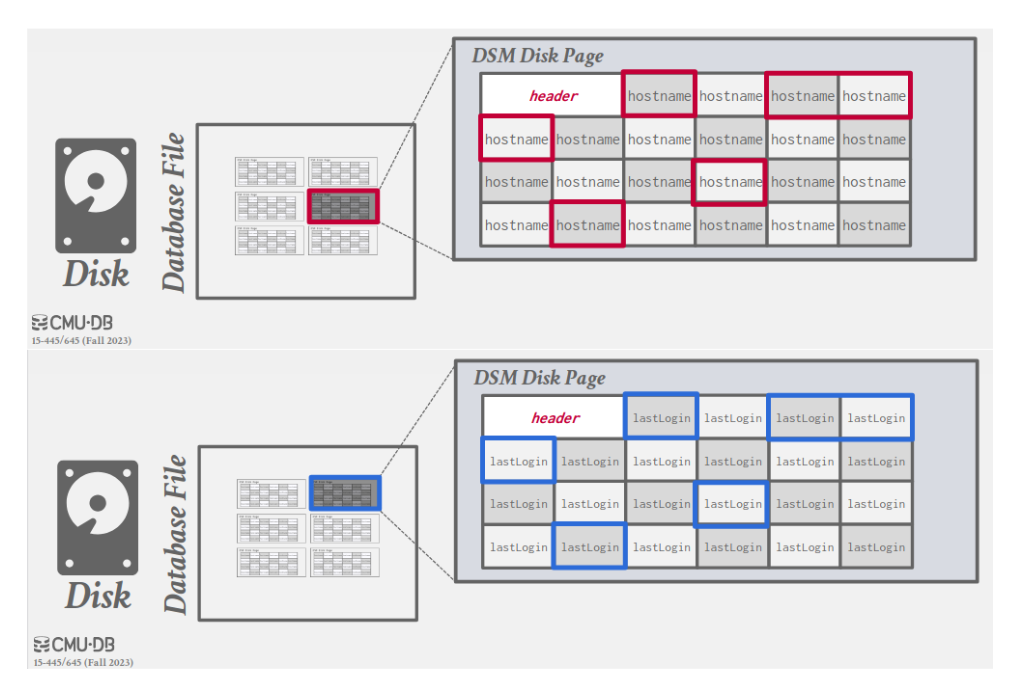
2.3. Partition Attributes Across (PAX)
- Rows are horizontally partitioned into groups of rows; each row group uses a column store.
- A PAX file has a global header containing a directory with each row group’s offset; each row group maintains its own header with content metadata.
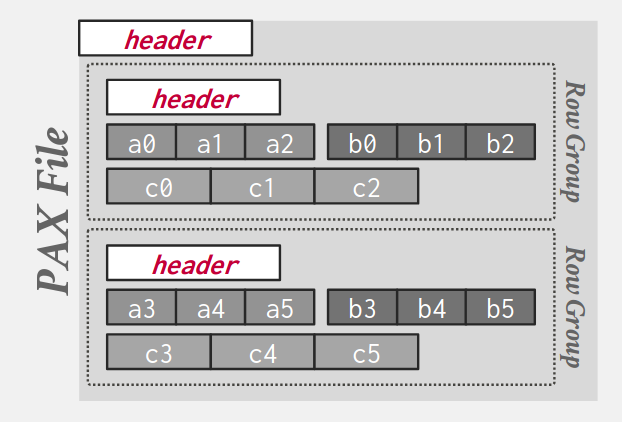
3. Database compression
- Disk I/O is always the main bottleneck; read-only analytical workloads are popular; compression in advance allows for more I/O throughput.
- Real-world data sets have the following properties for compression:
- Highly skewed distributions for attribute values.
- High correlation between attributes of the same tuple, e.g., zip code to city.
- Requirements on the database compression:
- Fixed-length values to follow word-alignment; variable length data stored in separate mappings.
- Postpone decompression as long as possible during query execution, i.e., late materialization.
- Lossless; any lossy compression can only be performed at the application level.
3.1. Compression granularity
- Block level: compress all tuples for the same table.
- Tuple level: compress each tuple (NSM only).
- Attribute level: compress one or multiple values within one tuple.
- Columnar level: compress one or multiple columns across multiple tuples (DSM only).
3.2. Naive compression
- Engineers often use a general purpose compression algorithm with lower compression ratio in exchange for faster compression/decompression.
- E.g., compress disk pages by padding them to a power of 2KBs and storing them in the buffer pool.
- Why small chunk: must decompress before reading/writing the data every time, hence need o limit the compression scope.
- Does not consider the high-level data semantics, thus cannot utilize late materialization.
4. Columnar compression
- Works best with OLAP, may need additional support for writes.
4.1. Dictionary encoding
- The most common database compression scheme, support late materialization.
- Replace frequent value patterns with smaller codes, and use a dictionary to map codes to their original values.
- Need to support fast encoding and decoding, so hash function is impossible.
- Need to support order-preserving encodings, i.e., sorting codes in the same order as original values, to support range queries.
- E.g., when
SELECT DISTINCTwith pattern-matching, the DBMS only needs to scan the encoding dictionary (but withoutDISTINCTit still needs to scan the whole column).
- E.g., when
4.2. Run-Length encoding (RLE)
- Compress runs (consecutive instances) of the same value in a column into triplets
(value, offset, length). - Need to cluster same column values to maximize the compression.
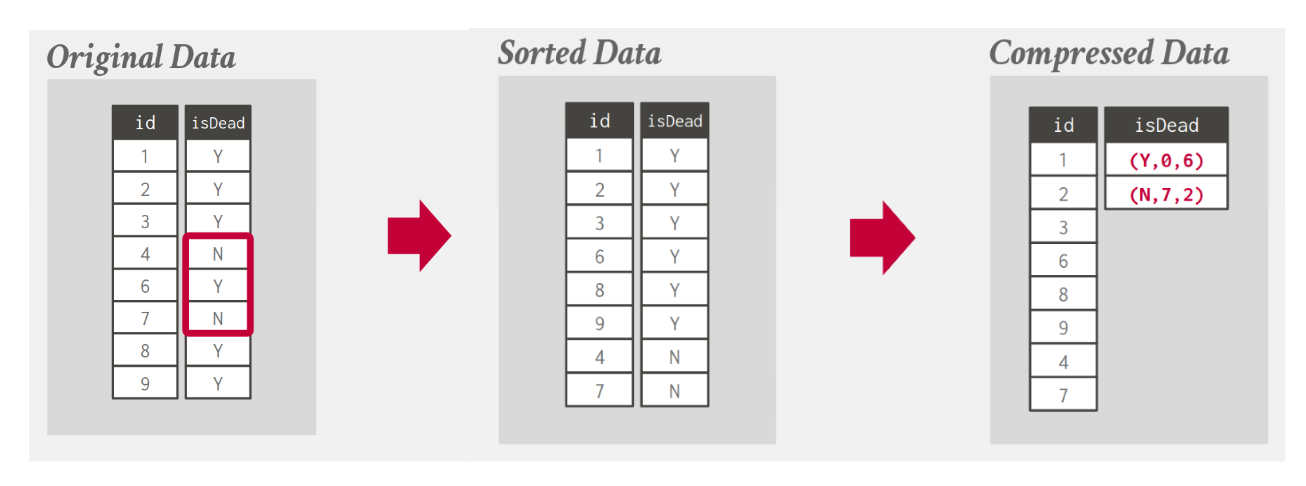
4.3. Bit-packing encoding
- Use less bits to store an attribute.

4.4. Mostly encoding
- Use a special marker to indicate values that exceed the bit size and maintains a look-up table to store them.

4.5. Bitmap (One-hot) encoding
- Only practical if the value cardinality is low.
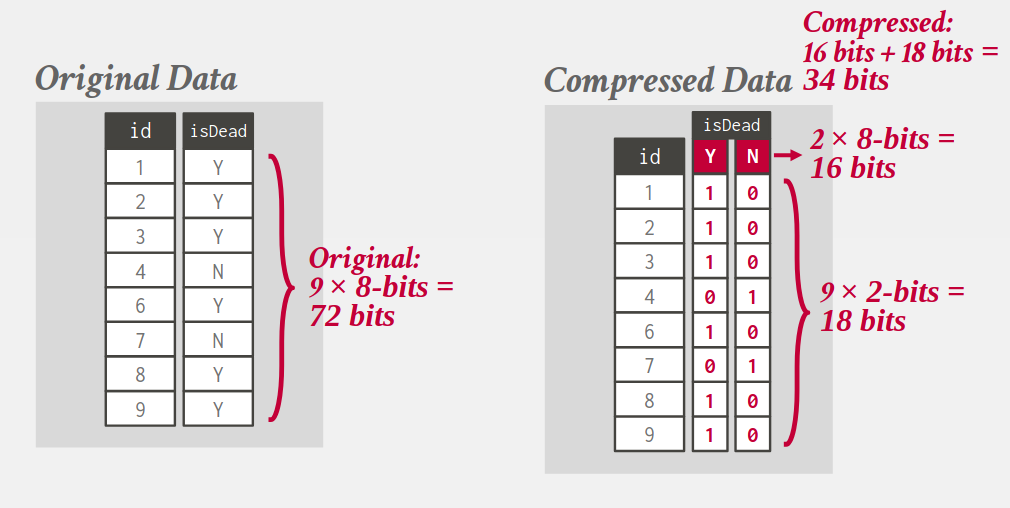
4.6. Delta encoding
- Record the difference between values; the base value can be stored in-line or in a separate look-up table.
- Can be combined with RLE encoding.

4.7. Incremental encoding
- Common prefixes or suffixes and their lengths are recorded to avoid duplication.
- Need to sort the data first.
CMU 15-445 notes: Database storage
This is a personal note for the CMU 15-445 L3 notes and CMU 15-445 L4 notes.
1. Data storage
1.1. Volatile device
- The data is lost once the power is off.
- Support fast random access with byte-addressable locations, i.e., can jump to any byte address and access the data.
- A.k.a memory, e.g., DRAM.
1.2. Non-volatile device
- The data is retained after the power is off.
- Block/Page addressable, i.e., in order to read a value at a particular offset, first need to load 4KB page into memory that holds the value.
- Perform better for sequential access, i.e., contiguous chunks.
- A.k.a disk, e.g., SSD (solid-state storage) and HDD (spinning hard drives).
1.3. Storage hierarchy
- Close to CPU: faster, smaller, more expensive.
1.4. Persistent memory
- As fast as DRAM, with the persistence of disk.
- Not in widespread production use.
- A.k.a, non-volatile memory.
1.5. NVM (non-volatile memory express)
- NAND flash drives that connect over an improved hardware interface to allow faster transfer.
2. DBMS architecture
- Primary storage location of the database is on disks.
- The DBMS is responsible for data movement between disk and memory with a buffer pool.
- The data is organized into pages by the storage manager; the first page is the directory page
- To execute the query, the execution engine asks the buffer pool for a page; the buffer pool brings the page to the memory, gives the execution engine the page pointer, and ensures the page is retained in the memory while being executed.
2.1. Why not OS
- The architecture is like virtual memory: a large address space and a place for the OS to bring the pages from the disk.
- The OS way to achieve virtual memory is to use
mmapto map the contents of a file in a process address space, and the OS is responsible for the data movement. - If
mmaphits a page fault, the process is blocked; however a DBMS should be able to still process other queries. - A DBMS knows more about the data being processed (the OS cannot decode the file contents) and can do better than OS.
- Can still use some OS operations:
madvise: tell the OS when DBMS is planning on reading some page.mlock: tell the OS to not swap ranges outs of disk.msync: tell the OS to flush memory ranges out to disk, i.e., write.
3. Database pages
- Usually fixed-sized blocks of data.
- Can contain different data types, e.g., tuples, indexes; data of different types are usually not mixed within the same page.
- Some DBMS requires each page is self-contained, i.e., a tuple does not point to another page.
- Each page is given a unique id, which can be mapped to the file path and offset to find the page.
3.1. Hardware page
- The storage that a device guarantees an atomic write, i.e., if the hardware page is 4KB and the DBMS tries to write 4KB to the disk, either all 4KB is written or none is.
- If the database page is larger than the hardware page, the DBMS requires extra measures to ensure the writing atomicity itself.
4. Database heap
- A heap file (e.g., a table) is an unordered collection of pages where tuples are stored in random order.
- To locate a page in a heap file, a DBMS can use either a linked list or a page directory.
- Linked list: the header page holds a pointer to a list of data and free pages; require a sequential scan when finding a specific page.
- Page directory: a DBMS uses special pages to track the location of each data page and the free space in database files.
- All changes to the page directory must be recorded on disk to allow the DBMS to find on restart.
5. Page layout
- Each page includes a header to record the page meta-data, e.g., page size, checksum, version.
- Two main approaches to laying out data in pages: slotted-pages and log-structured.
5.1. Slotted-pages
- The header keeps track of the number of used slots, the offset of the starting of each slot.
- When adding a tuple, the slot array grows from the beginning to the end, the tuple data grows from the end to the beginning; the page is full when they meet.
- Problems associated with this layout are:
- Fragmentation: tuple deletions leave gaps in the pages.
- Inefficient disk I/O: need to fetch the entire block to update a tuple; users could randomly jump to multiple different pages to update a tuple.
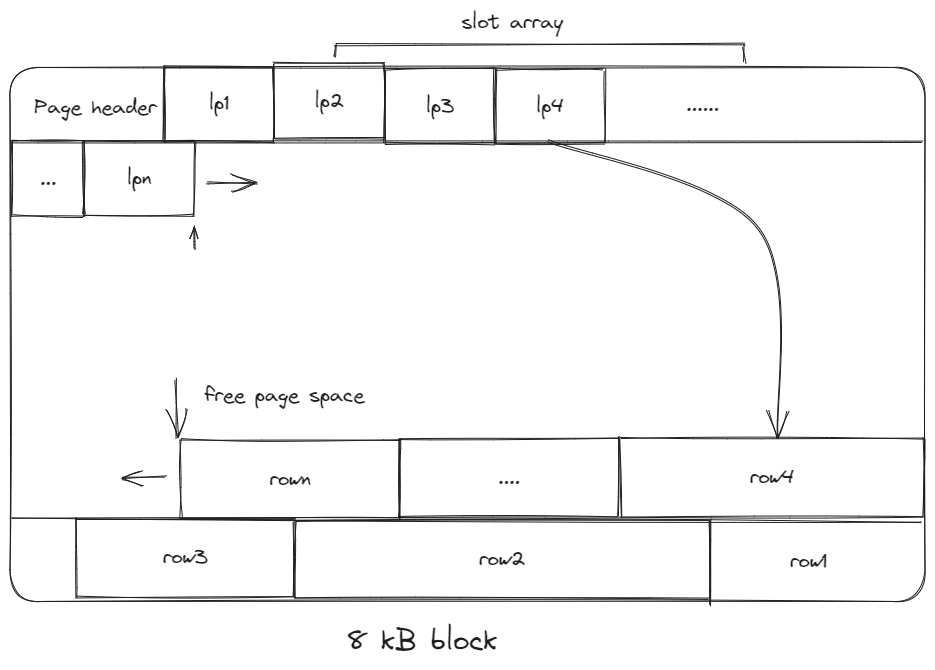
5.2. Log-structured
- Only allows creations of new pages and no overwrites.
- Stores the log records of changes to the tuples; the DBMS appends new log entries to an in-memory buffer without checking previous records -> fast writes.
- Potentially slow reads; can be optimized by bookkeeping the latest write of each tuple.
5.2.1. Log compaction
- Take only the most recent change for each tuple across several pages.
- There is only one entry for each tuple after the compaction, and can be easily sorted by id for faster lookup -> called Sorted String Table (SSTable).
- Universal compaction: any log files can be compacted.
- Level compaction: level 0 (smallest) files can be compacted to created a level 1 file.
- Write amplification issue: for each logical write, there could be multiple physical writes.
5.3. Index-organized storage
- Both page-oriented and log-structured storage rely on additional index to find a tuple since tables are inherently unsorted.
- In an index-organized storage scheme, the DBMS stores tuples as the value of an index data structure.
- E.g., In a B-tree indexed DBMS, the index (i.e., primary keys) are stored as the intermediate nodes, and the data is stored in the leaf nodes.
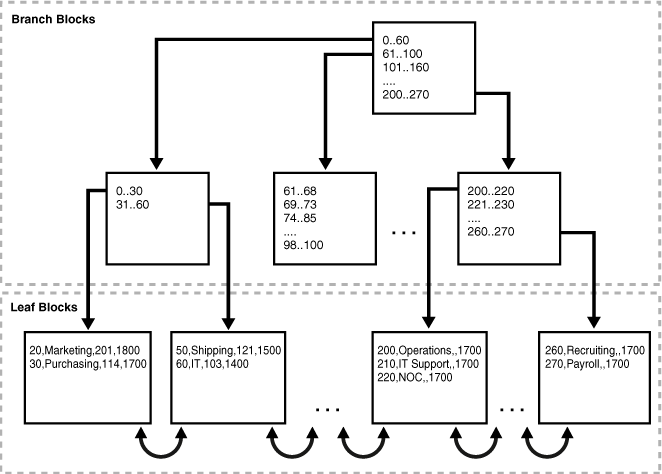
6. Tuple layout
- Tuple: a sequence of bytes for a DBMS to decode.
- Tuple header: contains tuple meta-data, e.g., visibility information (which transactions write the tuple).
- Tuple data: cannot exceed the size of a page.
- Unique id: usually page id + offset/slot; an application cannot rely on it to mean anything.
6.1. Denormalized tuple data
- If two tables are related, a DBMS can “pre-join” them so that the tables are on the same page.
- The read is faster since only one page is required to load, but the write is more expensive since a tuple needs more space (not free lunch in DB system!).
7. Data representation
- A data representation scheme specifies how a DBMS stores the bytes of a tuple.
- Tuples can be word-aligned via padding or attribute reordering to make sure the CPU can access a tuple without unexpected behavior.
- 5 high level data types stored in a tuple: integer, variable-precision numbers, fixed-point precision numbers, variable length values, dates/times.
7.1. Integers
- Fixed length, usually stored using the DBMS native C/C++ types.
- E.g.,
INTEGER.
7.2. Variable precision numbers
- Inexact, variable-precision numeric types; fast than arbitrary precision numbers.
- Could have rounding errors.
- E.g.,
REAL.
7.3. Fixed-point precision numbers
- Arbitrary precision data type stored in exact, variable-length binary representation (almost like a string) with additional meta-data (e.g., length, decimal position).
- E.g.,
DECIMAL.
7.4. Variable-length data
- Represent data of arbitrary length, usually stored with a header to keep the track of the length and the checksum.
- Overflowed data is stored on a special overflow page referenced by the tuple, the overflow page can also contain pointers to next overflow pages.
- Some DBMS allows to store files (e.g., photos) externally, but the DBMS cannot modify them.
- E.g.,
BLOB.
7.5. Dates/Times
- Usually represented as unit time, e.g., micro/milli-seconds.
- E.g.,
TIMESTAMP.
7.6. Null
- 3 common approaches to represent nulls:
- Most common: store a bitmap in a centralized header to specify which attributes are null.
- Designate a value, e.g.,
INT32_MIN. - Not recommended: store a flag per attribute to mark a value is null; may need more bits to ensure word alignment.
8. System catalogs
- A DBMS maintains an internal catalog table for the table meta-data, e.g., tables/columns, user permissions, table statistics.
- Bootstrapped by special code.
CMU 15-445 notes: Modern SQL
This is a personal note for the CMU 15-445 L2 notes, along with some SQL command explained by Claude.ai.
1. Terminology
1.1. SQL and relational algebra
- Relational algebra is based on sets (unordered, no duplicates); SQL is based on bags (unordered, allows duplicates).
- SQL is a declarative query language; users use SQL to specify the desired result, each DBMS determines the most efficient strategy to produce the answer.
1.2. SQL commands
- Data manipulation language (DML):
SELECT,INSERT,UPDATE,DELETE. Data definition language (DDL):
CREATE.CREATE TABLR student ( sid INT PRIMARY KEY, name VARCHAR(16), login VARCHAR(32) UNIQUE, age SMALLINT, gpa FLOAT );
- Data control language (DCL): security, access control.
2. SQL syntax
2.1. Join
Combine columns from one or more tables and produces a new table.
-- All students that get an A in 15-721 SELECT s.name FROM enrolled AS e, student AS s WHERE e.grade = 'A' AND e.cid = '15-721' AND e.sid = s.sid
2.2. Aggregation function
AVG(COL),MIN(COL),MAX(COL),COUNT(COL).Take as input a bag of tuples and produce a single scalar value.
-- Get number of students and their average GPA with a '@cs' login SELECT AVG(gpa), COUNT(sid) FROM student WHERE login LIKE '@cs'; -- Get the unique students SELECT COUNT(DISTINCT login) FROM student WHERE login LIKE '@cs';
Non-aggregated values in
SELECToutput must appear inGROUP BY.-- Get the average GPA in each course SELECT AVG(s.gpa), e.cid FROM enrolled AS e, student AS s WHERE e.sid = s.sid GROUP BY e.cid;
HAVING: filter output results based on aggregation computation.SELECT AVG(s.gpa), e.cid FROM enrolled AS e, student AS s WHERE e.sid = s.sid GROUP BY e.cid HAVING AVG(s.gpa) > 3.9;
2.3. String operation
- Strings are case sensitive and single-quotes only in the SQL standard.
- Use
LIKEfor string pattern matching:%matches any sub-string,_matches any one character
- Standard string functions:
UPPER(S),SUBSTRING(S, B, E). ||: string concatenation.
2.4. Date and time
- Attributes:
DATE,TIME. - Different DBMS have different date/time operations.
2.5. Output redirection
One can store the results into another table
-- output to a non-existing table SELECT DISTINCT cis INTO CourseIds FROM enrolled; -- output to an existing table with the same number of columns and column type -- but the names do not matter INSERT INTO CourseIds (SELECT DISTINCT cid FROM enrolled);
2.6. Output control
- Use
ORDER,ASCandDESCto sort the output tuples; otherwise the output could have different order every time. Use
LIMIT,OFFSETto restrict the output number.SELECT sid FROM enrolled WHERE cid = '15-721' ORDER BY UPPER(grade) DESC, sid + 1 ASC; LIMIT 10 OFFSET 10; -- output 10 tuples, starting from the 11th tuple
2.7. Nested queries
- Nested queries are often difficult to optimize.
- The inner query can access attributes defined in the outer query.
Inner queries can appear anywhere.
-- Output a column 'one' with 1s, the number of 1s -- equals to the number of rows in 'student' SELECT (SELECT 1) AS one FROM student; -- Get the names of students that are enrolled in '15-445' SELECT name FROM students WHERE sid IN ( SELECT sid FROM enrolled WHERE cid = '15-445' ); -- Get student record with the highest id -- that is enrolled in at least one course. SELECT student.sid, name FROM student -- the intermediate output is aliases as max_e JOIN (SELECT MAX(sid) AS sid FROM enrolled) AS max_e -- only select student who has the max_e ON student.sid = max_e.sid; -- the above is same as below, but `join` syntax is more preferred SELECT student.sid, name FROM student AS s, (SELECT MAX(sid) AS sid FROM enrolled) AS max_e WHERE s.sid = max_e.sid;
- Nested query results expression:
ALL: must satisfy expression for all rows in sub-query.ANY,IN: must satisfy expression for at least one row in sub-query.EXISTS: at least one row is returned.-- Get all courses with no students enrolled in SELECT * FROM course WHERE NOT EXISTS( SELECT * FROM enrolled WHERE course.cid = enrolled.cid ) -- Get students whose gpa is larget than the highest score in '15-712' -- and the login has a level > 3 SELECT student.sid, name FROM student AS S WHERE s.gpa > ALL ( SELECT course.score FROM course WHERE course.cid = '15-712' ) AND student.login IN ( SELECT login FROM enrolled WHERE level > 3 );
2.8. Window functions
- Perform sliding calculation across a set of tuples.
2.9. Common Table Expressions (CTE)
- An alternative to windows or nested queries when writing more complex queries.
CTEs use
WITHto bind the output of an inner query to a temporary table.WITH cteName (col1, col2) AS ( SELECT 1, 2 ) SELECT col1 + col2 FROM cteName;
CMU 15-445 notes: Relational Model & Algebra
This is a personal note for the CMU 15-445 L1 video and CMU 15-445 L1 notes, along with some terminology explained by Claude.ai.
1. Terminology
1.1. Database
- An organized collection of inter-related data that models some aspect of the real-world.
1.2. Database design consideration
- Data integrity: protect invalid writing.
- Implementation: query complexity, concurrent query.
- Durability: replication, fault tolerance.
1.3. Database management system (DBMS)
- A software that manages a database.
- Allow the definition, creation, query, update and administration of databases.
1.4. Data model
- A conceptual, high-level representation of how data is structured
- Defines entities, attributes, relationships between entities and constraints.
1.5. Schema
- A concrete implementation of a data model.
- Defines tables, fields, data types, keys and rules.
- Typically represented by a specific database language.
1.6. Entities and Tables
- Entities: conceptual representations of objects in the logical data model.
- Tables: physical storage structures in the physical data model.
1.7. Attributes and Fields
- Attributes: properties of an entity.
- Fields: columns in a database table.
1.8. Logical layer
- The entities and attributes the database has.
1.9. Physical layer
- How are entities and attributes stored in the database.
1.10. Data manipulation languages (DMLs)
- Methods to store and retrieve information from a database.
- Procedural: the query specifies the (high-level) strategy the DBMS should use to get the results, e.g., with relational algebra.
- Declarative: the query specifies only what data is desired but not how to get it, e.g., with relational calculus (a formal language).
1.11. SQL (Structured Query Language) and relational model
- SQL implements the relational model in DBMS and provides a standard way to create, manipulate and query relational databases.
- Different SQL implementation may vary and do not strictly adhere to the relational model, e.g., allow duplicate rows.
2. Relational model
- A data model that defines a database abstraction to avoid maintenance overhead when changing the physical layer.
- Data is stored as relations/tables.
- Physical layer implementation and execution strategy depends on DBMS implementation.
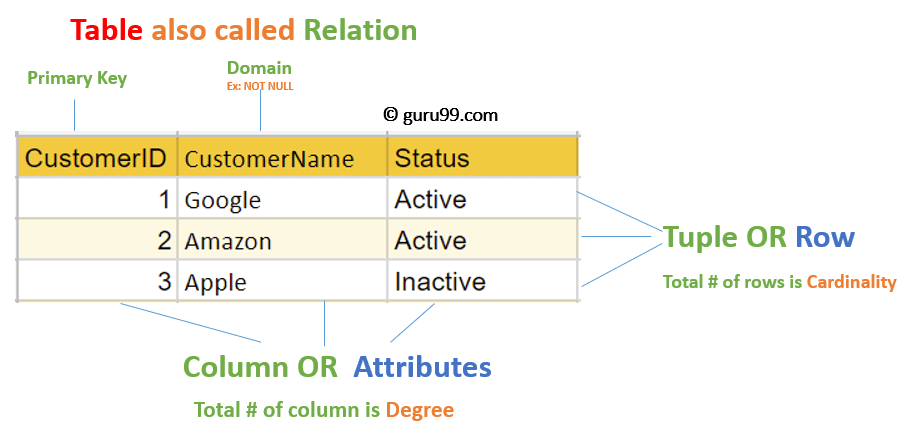
2.1. A relation
- An unordered set that contains the relationship of attributes that represent entities.
- Relationships are unordered in the relation.
2.2. A domain
- A named set of allowable values for a specific attribute.
2.3. A tuple
- A set of attribute values in the relation.
- Values can also be lists or nested data structures.
Null: a special value in any attribute which means the attribute in a tuple is undefined.- \(n-ary\): a relation with \(n\) attributes.
2.4. Keys
- Primary key: uniquely identifies a single tuple.
- Foreign key: specifies that an attribute (e.g.,
CustomerID) in one relation (e.g.,OrderTable) has to map to a tuple (e.g., the tuple with the sameCustomerID) in another relation (e.g.,CustomerTable).
3. Relational Algebra
- A set of fundamental operations to retrieve and manipulate tuples in a relation.
- Each operator takes in one or more relations as inputs, and outputs a new relation; operators can be chained.
- Is a procedure language, meaning the execution always follow the query, even there exists more efficient way to get the same result; A better way is to be more declarative, e.g., SQL’s
wheresyntax. - Common relational algebra.